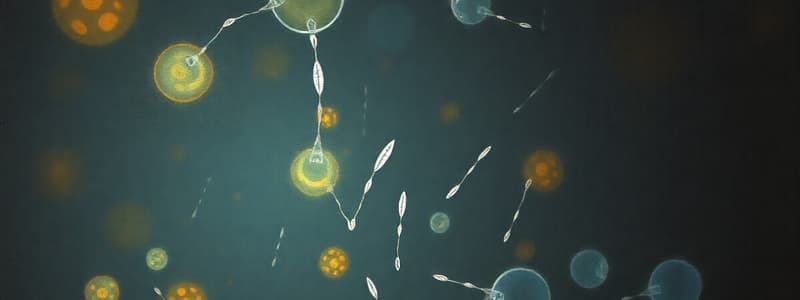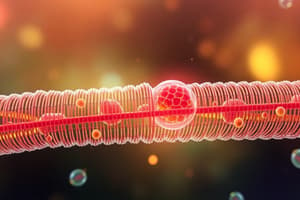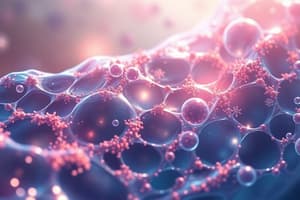Podcast
Questions and Answers
Which of the following is a characteristic of passive transport across cell membranes?
Which of the following is a characteristic of passive transport across cell membranes?
- Driven by the random motion of molecules. (correct)
- Movement of substances against their concentration gradient.
- Requires energy input from the cell.
- Always involves the use of transport proteins.
What does the term "concentration gradient" refer to in the context of diffusion?
What does the term "concentration gradient" refer to in the context of diffusion?
- The difference in pressure between two regions.
- The difference in electrical charge between two regions.
- The difference in temperature between two regions.
- The difference in the number of molecules of a substance per unit volume between two regions. (correct)
Which of the following substances would likely pass through a cell membrane most slowly?
Which of the following substances would likely pass through a cell membrane most slowly?
- Glucose
- Sodium ions (Na+) (correct)
- Oxygen gas (O2)
- Water
Which of the following statements is TRUE about diffusion?
Which of the following statements is TRUE about diffusion?
What is the main difference between passive and active transport?
What is the main difference between passive and active transport?
Which of the following statements accurately describes the fluid mosaic model of the plasma membrane?
Which of the following statements accurately describes the fluid mosaic model of the plasma membrane?
What type of molecule is most abundant in the plasma membrane?
What type of molecule is most abundant in the plasma membrane?
Which of the following molecules can easily cross the plasma membrane without the need for transport proteins?
Which of the following molecules can easily cross the plasma membrane without the need for transport proteins?
What is the primary reason for the lateral movement of phospholipids within the plasma membrane?
What is the primary reason for the lateral movement of phospholipids within the plasma membrane?
Which of the following is NOT a characteristic of integral membrane proteins?
Which of the following is NOT a characteristic of integral membrane proteins?
What is the function of peripheral membrane proteins in the plasma membrane?
What is the function of peripheral membrane proteins in the plasma membrane?
Which of the following best describes the ability of the plasma membrane to regulate the passage of substances across it?
Which of the following best describes the ability of the plasma membrane to regulate the passage of substances across it?
Which of these best describes the movement of a phospholipid molecule from one leaflet of the plasma membrane to the other?
Which of these best describes the movement of a phospholipid molecule from one leaflet of the plasma membrane to the other?
What is the primary driving force behind simple diffusion?
What is the primary driving force behind simple diffusion?
Which of the following molecules is most likely to cross a cell membrane via simple diffusion?
Which of the following molecules is most likely to cross a cell membrane via simple diffusion?
What is the key difference between open channels and gated channels?
What is the key difference between open channels and gated channels?
Which of the following is NOT a characteristic of facilitated diffusion?
Which of the following is NOT a characteristic of facilitated diffusion?
Which of the following best describes the role of carrier proteins in facilitated diffusion?
Which of the following best describes the role of carrier proteins in facilitated diffusion?
What is the primary source of energy for most active transport processes?
What is the primary source of energy for most active transport processes?
What is the key difference between facilitated diffusion and active transport?
What is the key difference between facilitated diffusion and active transport?
Which of the following is NOT a type of active transport?
Which of the following is NOT a type of active transport?
How does ATP contribute to active transport?
How does ATP contribute to active transport?
What is the key difference between primary and secondary active transport?
What is the key difference between primary and secondary active transport?
What is the primary role of the sodium-potassium pump in animal cells?
What is the primary role of the sodium-potassium pump in animal cells?
How does the phosphorylation of the sodium-potassium pump carrier protein contribute to its function?
How does the phosphorylation of the sodium-potassium pump carrier protein contribute to its function?
What is the main difference between symport and antiport cotransport mechanisms?
What is the main difference between symport and antiport cotransport mechanisms?
Which of the following is an example of a cotransport mechanism?
Which of the following is an example of a cotransport mechanism?
What is the role of vesicles in bulk transport?
What is the role of vesicles in bulk transport?
Which type of endocytosis specifically involves the uptake of specific molecules?
Which type of endocytosis specifically involves the uptake of specific molecules?
What is the main difference between exocytosis and endocytosis?
What is the main difference between exocytosis and endocytosis?
Which of the following is NOT a type of endocytosis?
Which of the following is NOT a type of endocytosis?
Flashcards
Hydrophilic substances
Hydrophilic substances
Substances that are attracted to water and can dissolve in it.
Hydrophobic interior
Hydrophobic interior
The part of a membrane that repels water and hydrophilic substances.
Passive transport
Passive transport
Movement of substances across a membrane without energy input from the cell.
Diffusion
Diffusion
Signup and view all the flashcards
Active transport
Active transport
Signup and view all the flashcards
Simple Diffusion
Simple Diffusion
Signup and view all the flashcards
Concentration Gradient
Concentration Gradient
Signup and view all the flashcards
Facilitated Diffusion
Facilitated Diffusion
Signup and view all the flashcards
Tunnel Proteins
Tunnel Proteins
Signup and view all the flashcards
Carrier Proteins
Carrier Proteins
Signup and view all the flashcards
ATP
ATP
Signup and view all the flashcards
Osmosis
Osmosis
Signup and view all the flashcards
Types of Transport
Types of Transport
Signup and view all the flashcards
Plasma Membrane
Plasma Membrane
Signup and view all the flashcards
Phospholipids
Phospholipids
Signup and view all the flashcards
Amphipathic Molecules
Amphipathic Molecules
Signup and view all the flashcards
Fluid Mosaic Model
Fluid Mosaic Model
Signup and view all the flashcards
Integral Proteins
Integral Proteins
Signup and view all the flashcards
Peripheral Proteins
Peripheral Proteins
Signup and view all the flashcards
Semi-permeable
Semi-permeable
Signup and view all the flashcards
Selective Transport
Selective Transport
Signup and view all the flashcards
Na+-K+-Pump
Na+-K+-Pump
Signup and view all the flashcards
Cotransport
Cotransport
Signup and view all the flashcards
Symport
Symport
Signup and view all the flashcards
Antiport
Antiport
Signup and view all the flashcards
Bulk transport
Bulk transport
Signup and view all the flashcards
Exocytosis
Exocytosis
Signup and view all the flashcards
Endocytosis
Endocytosis
Signup and view all the flashcards
Phagocytosis
Phagocytosis
Signup and view all the flashcards
Study Notes
Plasma Membranes
- Plasma membranes are approximately 8nm thick (8000 times the thickness of paper).
- They control the passage of substances into and out of cells.
- They exhibit selectivity in chemical exchange, a fundamental characteristic of living cells.
Membrane Structure
- Membranes are primarily composed of phospholipids and proteins, with carbohydrates also playing a role.
- Phospholipids are the most abundant molecules, forming a bilayer.
- Phospholipids are amphipathic, possessing hydrophilic heads and hydrophobic tails.
- Proteins are also amphipathic, with both hydrophilic and hydrophobic regions.
Fluid Mosaic Model
- Membranes are fluid structures with a mosaic of embedded proteins within (or attached to) a phospholipid bilayer.
- Proteins and phospholipids are not rigidly fixed in place, but the tails of the phospholipids are held together by hydrophobic interactions.
Membrane Protein Diversity
- Membrane proteins are categorized into integral and peripheral proteins.
- Integral proteins penetrate the hydrophobic interior of the membrane, often traversing the entire membrane (transmembrane proteins).
- Peripheral proteins are not embedded within the membrane but are loosely associated with the hydrophilic portions of integral proteins or other membrane surfaces.
Membrane Transport
- Biological membranes are selectively permeable, meaning they regulate the movement of substances across their boundaries.
- Nonpolar molecules (e.g., hydrocarbons, O2, CO2) readily cross the lipid bilayer.
- Polar molecules (e.g., water) and ions diffuse more slowly through the membrane or via membrane proteins.
Passive Transport
- Passive transport does not require energy input from the cell.
- It follows the concentration gradient, moving substances from high to low concentration.
- Simple diffusion - molecules move across a membrane without assistance.
- Facilitated diffusion - molecules move across a membrane through proteins.
Active Transport
- Active transport requires energy input from the cell.
- It moves solutes against their concentration gradient (from low to high concentration).
- The most common energy source is ATP.
- Includes several types: primary, secondary, bulk (exocytosis, endocytosis).
Osmosis
- Osmosis is the diffusion of water across a selectively permeable membrane.
- It moves water from high to low water concentration.
- Key terms: isotonic, hypertonic, hypotonic solutions. Cell response to different solutions vary depending on if the cell has or does not have a cell wall
Types of Transmembrane Proteins
- Channels – allow molecules to pass through by providing a tunnel.
- Carriers – bind to molecules and change shape, facilitating their movement across the membrane.
Other Forms of Bulk Transport
- Exocytosis – materials are released from the cell in vesicles.
- Endocytosis – materials are taken into the cell in vesicles. There are three types:
- Phagocytosis (“cell eating”) – solids
- Pinocytosis (“cell drinking”) – liquids
- Receptor-mediated endocytosis – specific molecules.
Sodium-Potassium Pump
- Active transport mechanism that moves Na+ out of the cell and K+ into the cell (against their concentration gradients).
- Crucial role in maintaining cell volume and nerve impulse transmission
Studying That Suits You
Use AI to generate personalized quizzes and flashcards to suit your learning preferences.




